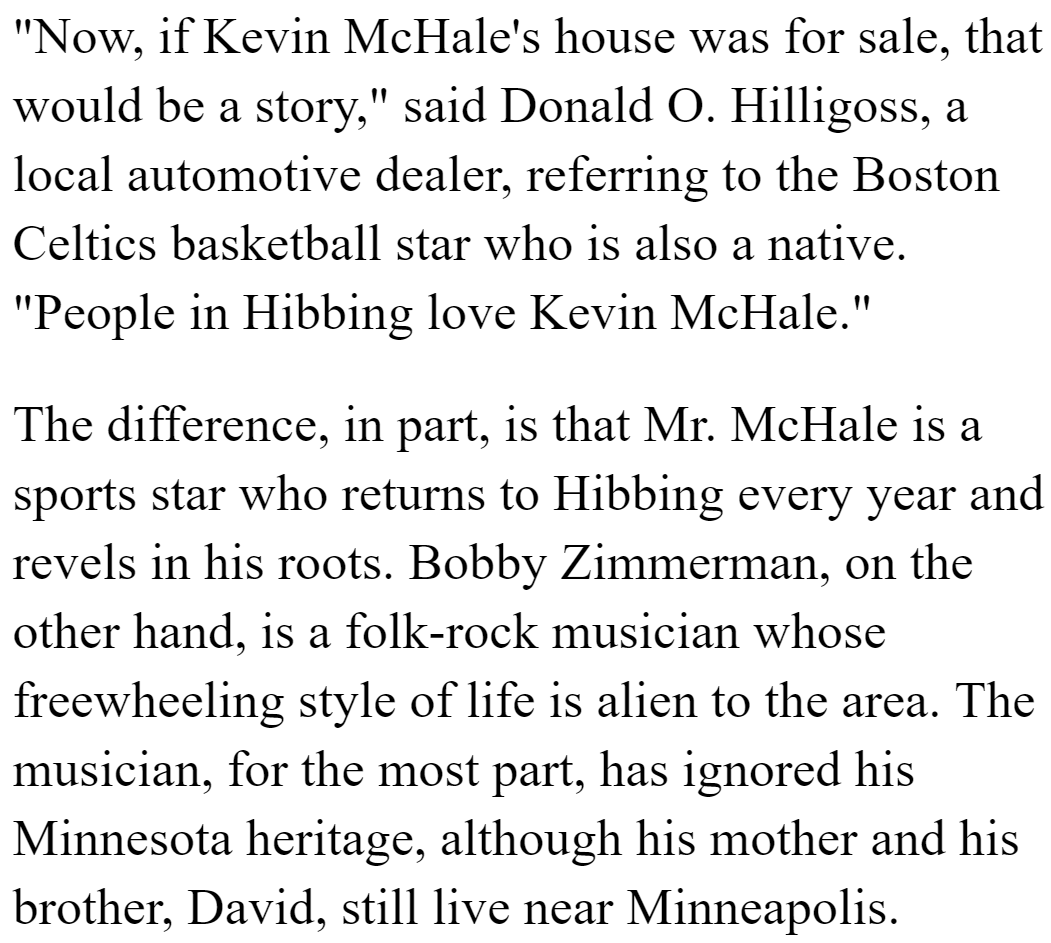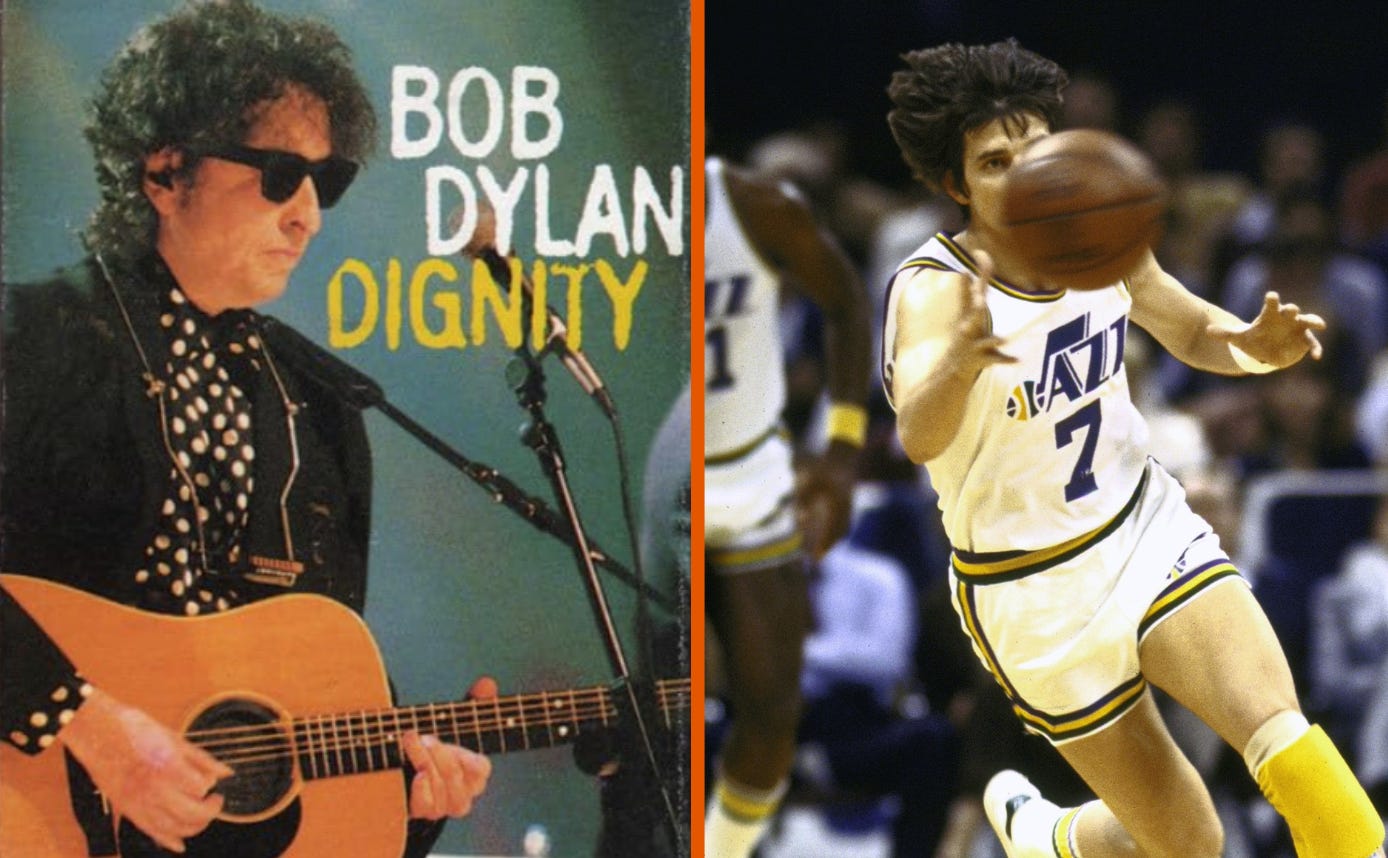
Bob Dylan sang, “Something is happening here, but you don't know what it is.”
And it’s true: I had no idea just how much Dylan is into basketball.1 He might have been The Voice of a Generation, but he is also A Fan of the Game.
As he approaches his 83rd birthday this month — and prepares the latest leg of his Never Ending Tour — check out the crossovers between Bob and basketball.
"May you stay forever young.”

“Everybody must get stoned.”
Cheech & Chong are known for their stoner comedy movies like Up in Smoke.
In hoops, though, their claim to fame is their hit single “Basketball Jones” — improvised while Jack Nicholson was driving them to a Lakers game.
But they weren’t only fans, and they relished facing off against Dylan in the driveway … as Tommy Chong made clear in Cheech & Chong: The Unauthorized Autobiography.
“I'll remember you when I've forgotten all the rest.”
Dylan, who was born Robert Allen Zimmerman in 1941, appears to have come by his interest in basketball naturally.
According to Dylan historian James Adams, “Abram Zimmerman — Bob Dylan's father — played basketball as a young man. This photo from 1930 shows ‘Abe’ sitting at far right with his team in the same year they won a tournament in Minneapolis. Standing above Abe is his brother Paul, the team's coach.”
“Ah, but I was so much older then; I'm younger than that now.”
In On the Road with Bob Dylan, author Larry Sloman asked Dylan’s mom about Bob as a kid. She recalled:
Oh, he played the guitar and he liked basketball and baseball. He liked sports, he was always a goer and a doer. He always did everything. He was a joiner, he joined in on everything.
In contrast, Dylan rarely gives straight answers in interviews, typically treating the questions as ridiculous and invasive. Here’s an example from April 1966:2
I never was a teenager. I never played football, basketball, soccer. I never was at track meets. I never got good grades at school. I never was in the Honor Society. I never graduated in high degrees. I never took an interest in anything.
"When you've got nothing, you've got nothing to lose."
By 1969, Dylan was deep into a more reclusive phase of life after years of touring and international renown. He had moved back to Greenwich Village with his family, and he liked to shoot on the outdoor courts there.
One fellow hoopster, David Reitman, spent long hours playing and shooting, sometimes in hope that Dylan would show up. One day, Bob did, asking, “Mind if I shoot here?”
Reitman wrote up the occasion:
He was wearing $20 Adidas sneakers — a useless bourgeois extravagance. I was wearing $9 Cons.
They played one-on-one and Reitman won a close game to 10. According to Reitman, he never revealed that he recognized Dylan.
He concluded his story noting that he saw Dylan once more:
But on the first warm Sunday of this year, when the temperature climbed into the mid-40s, the basketball freaks were out there playing. I was passing that playground in a taxi when I noticed, in a heavy ski sweater and sunglasses and $20 Adidas, Bob Dylan, shooting baskets, alone.
"I'll let you be in my dreams if I can be in yours."
Basketball Hall of Famer Kevin McHale and Bob Dylan both hail from Hibbing, a small mining town in northern Minnesota. And their admiration appears mutual, as captured by Chicago Tribune sportswriter Bob Sakamoto in this 1985 anecdote from McHale:
A year later, music journalist Jon Bream caught a similar vibe backstage after a Dylan concert in Minneapolis:

But that doesn’t mean they are equally beloved in Hibbing.
When Dylan’s childhood home went up for sale in 1988, local folks tended to be apathetic or even resentful about “that weird kid” who moved away as quickly as possible to chase success
From the New York Times in 1988:
“The ghost of ’lectricity howls in the bones of her face.”
On May 29, 2012, President Obama awarded legendary coach Pat Summitt and Bob Dylan the Medal of Freedom, the United States’ highest civilian honor.
The previous month, Summitt had stepped down as the Tennessee Lady Vols’ coach because of early-onset Alzheimer's, as referenced by Obama in his presentation. She died in 2016.
“Every hair is numbered like every grain of sand.”
To capture Julius Erving in team colors, the 76ers found inspiration in the famous ‘66 poster of Dylan. The original was designed by Milton Glaser, also known for his classic I❤️NY logo.
"Time is a jet plane, it moves too fast."
“Pistol” Pete Maravich died at age 40 while playing pickup basketball.
In his memoir Chronicles, Dylan wrote that he composed the song “Dignity” the following day upon hearing the news. He added these reflections:
Pistol Pete hadn’t played professionally for a while, and he was thought of as forgotten. I hadn’t forgotten about him, though. Some people seem to fade away but then when they are truly gone, it’s like they didn’t fade away at all.
More from Dylan’s Chronicles:
I'd seen Maravich play in New Orleans once, when the Utah Jazz were the New Orleans Jazz. He was something to see — mop of brown hair, floppy socks— the holy terror of the basketball world — high flyin' — magician of the court. The night I saw him he dribbled the ball with his head, scored a behind the back, no look basket — dribbled the length of the court, threw the ball up off the glass and caught his own pass. He was fantastic. Scored something like thirty-eight points. He could have played blind.
“It's just a shadow you're seeing that he's chasing.”
Dylan’s famous Rolling Thunder Revue tour was just a trial balloon when he shot hoops with his friend Roger McGuinn, the frontman for the Byrds, who had their first No. 1 hit with their cover of Dylan’s “Mr. Tambourine Man.”
“Try imagining a place where it's always safe and warm.”
Dylan is converting a 144-year-old Louisville church — and its basketball gym — to a bourbon bar called The Last Refuge.
The establishment — which says, “We’ll be open very soon.” — takes its name from the church basketball team, known as Refuge in Kentucky, and from the lyrics to “Sweetheart Like You,” a 1983 Dylan song which sounds prescient today:
They say that patriotism is the last refuge
To which a scoundrel clings
Steal a little and they throw you in jail
Steal a lot and they make you king
“Johnny's in the basement, mixin' up the medicine.”
Dylan launched the box set era with his 1985 release Biograph, featuring 53 tracks and a 36-page booklet with rare photos.
Here’s a page from the official liner notes, composed by Almost Famous writer/director Cameron Crowe.
This image reminds me of the original inspiration for this article you’re reading. For more on that and other sources, see the footnotes.3
“I’ll tell it and think it and speak it and breathe it, and reflect it from the mountain so all souls can see it.”
Bill Walton is famously a massive fan of the Grateful Dead … and of Dylan.
Of course, Walton is also famous for taking tangents — working his favorite topics into his highly colorful color commentary.
Here is Walton’s Dylan testimony from 2015, including graphics from the ESPN production team:
“The times they are a-changin’.”
In 2015, celebrated street artist Eduardo Kobra painted a five-story Dylan mural in Minneapolis.
In 2022, looking to follow up their popular City Edition jerseys of previous years — including one inspired by Minneapolis native Prince — the Timberwolves looked to another local artist, Dylan.
In his 16 formative months in Minneapolis, Bobby Zimmerman enrolled at the University of Minnesota, took the name Bob Dylan, and spent most of his time off-campus getting a musical education before moving to New York to make his new name.
While the Wolves’ publicity focused on broader artistic inspiration beyond the mural, the uniforms as well as the team’s first-ever alternate court were widely regarded to use the patterns of the Dylan mural as their primary motif.
Reviews were mixed-to-negative.
Casey Vitelli of NBA Uniform Tracker, in concert with Brooks Davis of Minnesota-based sports site Zone Coverage, mocked up his own version of the court, with a more direct homage to Dylan and the mural:

“5 x 5, they tried to survive.”
Dylan sported hightop Nikes on the back cover of his 1990 album Under the Red Sky … which includes the song “2 x 2” and, yes, the lyrics above.
“You don’t need a weatherman to know which way the wind blows.”
Dylan’s outdoor basketball court at his Malibu home is a beaut — a smooth halfcourt in tennis green with a painted blue lane and a 3-point line that appears to be at the old college (or current high school) distance of 19’9”.
We know this because there are plenty of satellite and other aerial images available these days, via Google Maps and other sources.4
But we also know that Dylan — despite being one of the most prolific public figures ever, via songs, interviews, books, documentaries, radio shows, and more — values his privacy.
So rather than show Bob’s home court, I’ll show a similar one:
“I wish that for just one time you could stand inside my shoes.”
Dylanologists James Adams and Harry Hew provide invaluable resources for Dylan notes and images, including some of the images in this piece.
For the full transcript as well as an audio version of the interview, click here. Thanks to Harry Hew for the tip.
Years ago, my brother Tim — and a friend of his — planted the seed for what you’re reading today. The friend was responsible for a college gym, and Dylan was scheduled to play a concert on campus. Before the show, Dylan, his band and some of his crew headed to the gym and wanted to play. Problem was, they were wearing shoes — Dylan was in boots — unsuited for basketball. Tim’s friend said they could play … if they took off their shoes. So, for a quarter-century, I’ve carried around a mental image of Dylan and a bunch of dudes playing basketball in socks.
It was another aerial shot of a Malibu estate that gave rise to the Streisand Effect.


























Wow! Really fun article!
I thoroughly enjoyed this and like Dylan even more.